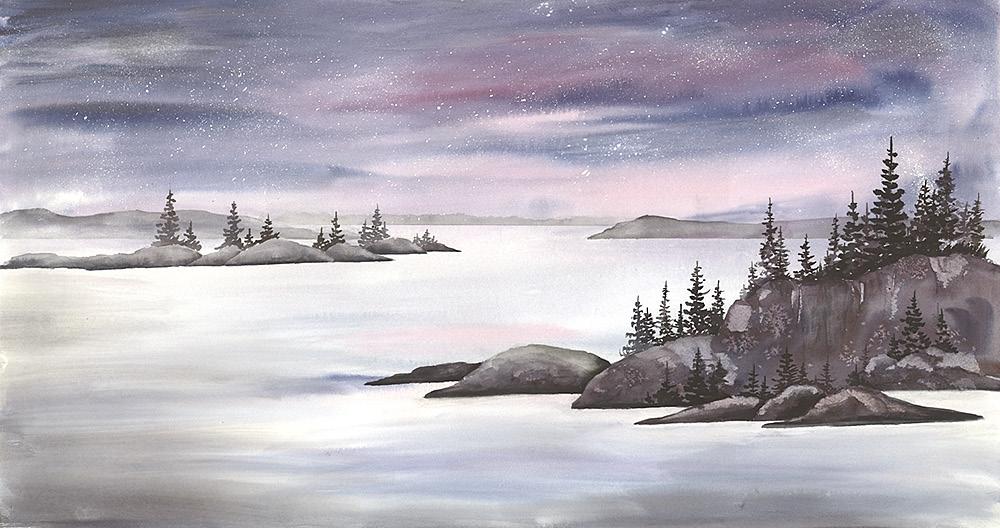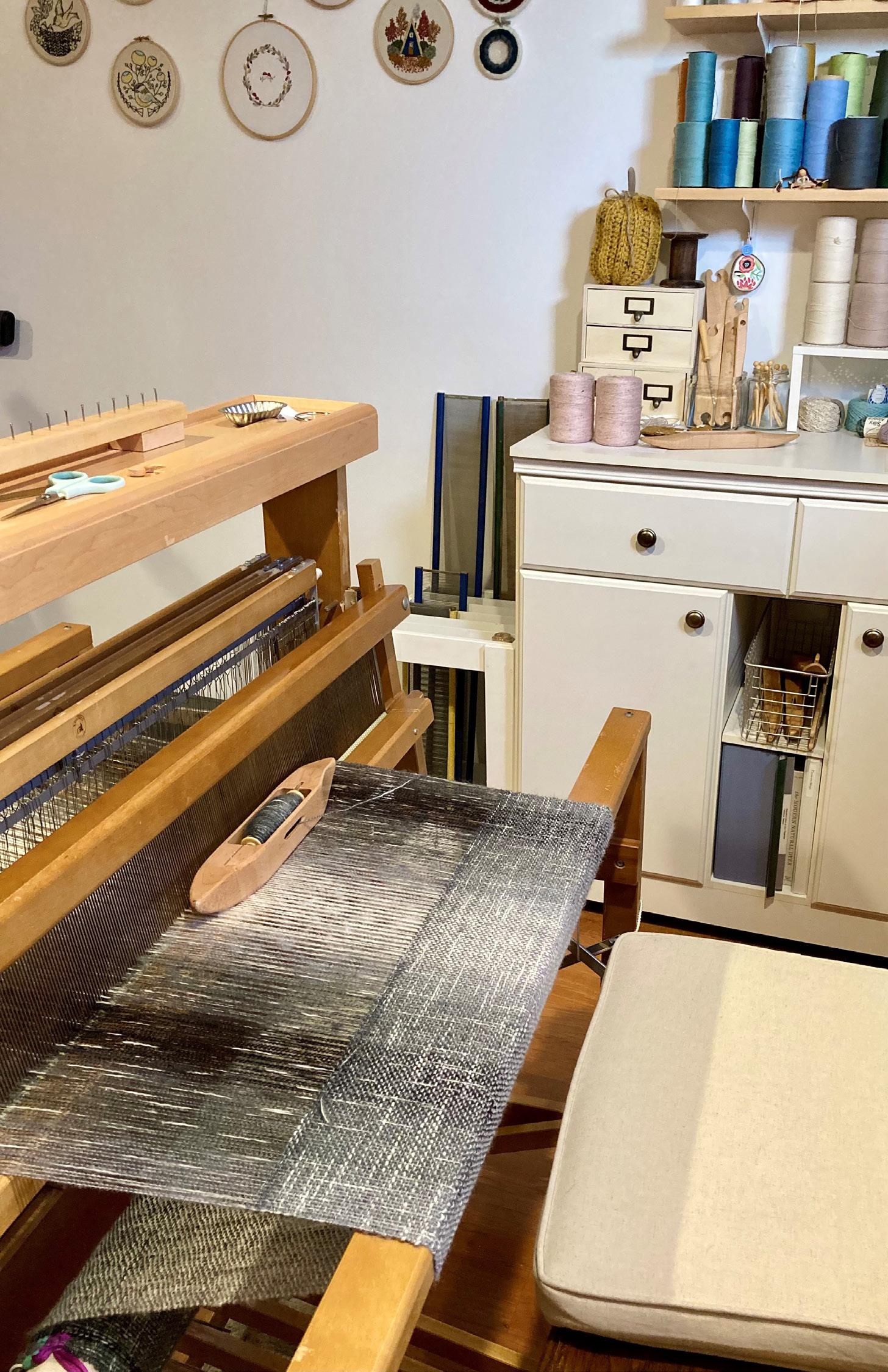
9 minute read
Spotlight
Aaron Kloss recently finished this 30x24-inch acrylic on canvas piece, titled “Winter Night Lights.” To see more from Kloss, visit: aaronkloss.com. | AARON KLOSS
Enjoying Winter
Advertisement
By Breana Johnson
Along the North Shore, winter tends to last longer than any other season. While some of us may groan about the deep snow and cold temps, the best way to enjoy winter is to get outdoors and embrace it. From skiing, snowshoeing and snowmobiling, to ice fishing, sledding and ice skating, there’s no shortage of winter activities. So go outside and enjoy your snowy surroundings.

This 20x20-inch acrylic on panel by Jennifer Caie is titled “Bright and Blue.” You can see more of her work online at: jennifercaieart.ca. | JENNIFER CAIE

This ink and watercolor piece, titled “Blankie” by Betsy Bowen, is now part of Bowen’s new book, Comfort in a Time of Pandemic: A Sketchbook. Learn more at: woodcut.com. | BETSY BOWEN

“Untitled (1999)” by Howard Sivertson, will be on display at the Johnson Heritage Post Gallery in Grand Marais from Jan. 7-30 as part of the Dropping Anchor exhibition. | HOWARD SIVERTSON

This colorful acrylic piece by Anna Hess is titled “Raven Berry.” To see more of her work, visit: alwhessart.com. | ANNA HESS

Thunder Bay watercolor artist Biljana Baker titled this piece “Winter’s Glow.” You can find her work online at: biljanabakerartist.ca. | BILJANA BAKER
Lacewood Fibre Studio
CREATIVE SPACE: By Rae Poynter
When Heather Ellam signed up for a weekend course in weaving, she had no idea that it was going to lead to a new passion and a new business. Born and raised in Thunder Bay, Ellam is the owner of Lacewood Fibre Studio, where she makes handwoven clothes and homeware on her very own loom.
While she did not start weaving until she was an adult, Ellam said that she is a longtime crafter and comes from a family of women who love sewing, knitting and crafting. With her own experience in sewing and needlepoint, Ellam had long found the idea of weaving intriguing, but never had the chance to try it. That is, until the local Weaver’s Guild hosted a weekend course in weaving, and she decided to join. As part of the course, Ellam got to learn in class and then take a loom home to practice, and she created her first 8-inch scarf.

“After taking the class, I saw the potential of weaving and it really appealed to me,” she said. “I started looking around online for a loom and found a lady in Duluth who was selling a used one, so I drove down and brought it home.”
With her own loom, Ellam started experimenting with weaving on her own. Apart from her initial class, she mostly learned the craft on her own, checking out books and exploring with different weave structures as she went. Today, she makes a wide range of items, from shawls and sweaters to blankets and napkins. She said that she takes inspiration from many different places, whether that’s Pinterest boards or a color combination that piques her interest.
“I try to keep what I make timeless. I follow some trends, but I try not to follow them too much so that people can wear what they buy for a long time,” she said.
The weaving process starts with a pattern called a draft, which tells the weaver how to set up the loom to achieve the desired weave. It involves a fair amount of pre-planning, including setting up all of the colors that will be used in the finished piece. Ellam said that the front-end work can take a few hours before any actual weaving can begin.
“The first couple of times that you do it, it’s tricky,” she said. “After the first course I took it was hard to remember all of the steps on my own. But you learn from trial and error. Now I’ll listen to a podcast or a vlog while I set up the loom, and the relaxing part is when you actually start weaving.”

After taking a class and purchasing her own loom, Ellam started experimenting with weaving on her own. Today, she makes a wide range of items, from shawls and sweaters to blankets and napkins. She said that she takes inspiration from many different places, whether that’s Pinterest boards or a color combination that piques her interest. | SUBMITTED
Ellam said that she gets her yarns from a variety of sources, and likes to support small or local businesses when she can. Some of her favorite suppliers include cotton yarn from Maurice Bassard, a family-owned business based in Quebec, and Gist Yarn, which has a line of yarns that are all grown, milled, and spun in the U.S. Some of Ellam’s scarves use merino wool dyed by independent dyers.
The evolution from weaving as a hobby to also being a small business began when Ellam started bringing her work to farmer’s markets and craft shows in the area. Then, when the pandemic hit, she decided to move Lacewood Fibre Studio’s presence online, and opened up her Etsy shop. Ellam said that even as she has moved into selling her work, it’s important to her that weaving doesn’t become a chore and that it remains something she loves doing.
“I like the versatility that weaving has,” Ellam said. “You don’t always have to be making an actual item, you can just make fabric and do whatever you want with it later. And I like that, like all fiber arts, it’s going back to the basics. There’s no electronic equipment on the loom: with all of the advances in technology we have, looms pretty much stay the same, and I like that we can just come back to something as timeless as making cloth.”
Heather Ellam’s work can be found on Etsy through lacewoodfibrestudio.com, as well as on Instagram @lacewood.fibre. studio.
The Alchemy of Water and Weaving
Behind the Craft: By Christine Novotny
When I moved to Grand Marais at the beginning of 2020, I had never lived by so much water before. I came from Minneapolis for a multi-year weaving residency with North House Folk School. In the city, I had grown accustomed to seeing very little sky, and never an unencumbered horizon line. Seeing the stars at night again and the mutable moods of Lake Superior both calmed and invigorated me. The pandemic hit very quickly after I arrived, so my immediate world shrank to my home and my weaving studio, but expanded with the lake and woods at my doorstep. I came into this residency with a whole set of ideas about what I wanted to weave—patterns and colors I was used to working with. However, as I began to work and spend a lot of time outside, my fluid surroundings began to creep into each textile.

This shawl was inspired by watching the sunrise behind the Whole Foods Co-op, with streaks of dappled orange clouds floating in the blue mist. | SUBMITTED
“Inspiration” is a concept I’ve never much related to. The idea feels linear, a precursor to the creation: go out, find inspiration, make something new from said inspiration. But that’s not usually how it shows up for me. I see ideas as a relationship, a slow and constant burn. As I work, images, colors and movement come to me, in small glimpses. Through attention and effort, I create new designs and textiles. With time and distance, I am able to see my subconscious at work, and to make connections between my life and the piece. Over the past two years, I have experienced this happening again and again with the big lake down the street.
My first project upon arriving at North House Folk School was a series of towels in Jämtlandsdräl, a graphic patterned weave structure originating in Sweden. I wove with a combination of colors that I had never used before, and after the towels came off the loom, the lakeshore was evident. I had woven a large diamond pattern in a bright burnt orange, the color of the iconic, elegant sunburst lichen that graces the lake’s rocky shores. I wove a shimmering diamond pattern in tinted and dark blues with stripes of beige that reflected the many colors the water takes and the rocks that rest beneath it.

In the winter, I released a woolen shawl with a white to blue gradient in the warp and a cascading blue diamond pattern with bright stripes of coral and orange woven throughout. As I sat with the finished work, I remembered the many mornings in fall of 2020 as the pandemic raged, when I went on walks in search of wonder. I always found myself at the beach behind the Whole Foods Co-op, watching the sun rise with streaks of dappled orange clouds floating in the blue mist.
I love mid-century weaver Anni Albers’ “no frills” definition of weaving: “the intricate interlocking of two sets of threads at right angles.” It beautifully encompasses the simplicity of the weaving, while the adjective “intricate” gently nods at the exponential complexities that this interlocking can produce. What I treasure most about weaving is the alchemy of the process, taking a few cones of yarn and guiding their transformation. Laying them next to each other at right angles, overlapping in different proportions, and creating a flexible form with structure and pattern. The ability of right angles to create the appearance of curves and organic forms, using different materials to impact the way light moves on a textile. There is a transformation that occurs from raw materials to a woven textile. In turn, water is the most powerful element on earth, with an extraordinary ability to smooth glass, carve out canyons, and create channels in the sand. Two transformative processes, water and weaving, find relationship with one another.

After this towel came off the loom, the lakeshore was evident. The large diamond pattern in bright burnt orange reflects the color of the sunburst lichen that graces the lake’s rocky shores. | SUBMITTED
I am currently working on a series of towels based on the “Water is Life” movement, a fundraiser for legal fees of water protectors defending our most precious resource against oil pipelines. This time, I began with the direct connection to the lake, using lustrous blue linen weft to create the appearance of ripples and waves on a cotton ground. The gray-blue in the linen is a strikingly accurate portrayal of the way the lake looks during fall and winter days. I’m using another variation of Jämtlandsdräl, the first weave structure I used on my lakeshore towels when I moved here. I’m coming full circle almost two years later, from the chance inspiration to a deliberate depiction, as I treasure the ways that this landscape has changed me, and changed the art I create.
Christine Novotny is a weaver in the Artisan Development program at North House Folk School, where traditional craft is taught on the shore of Lake Superior.







